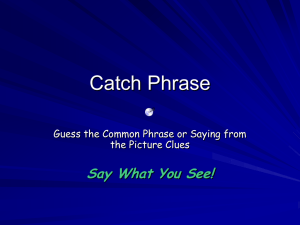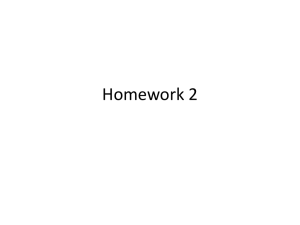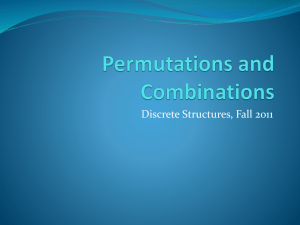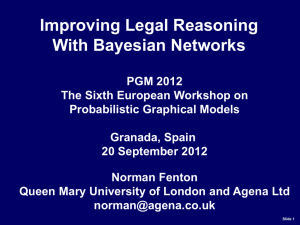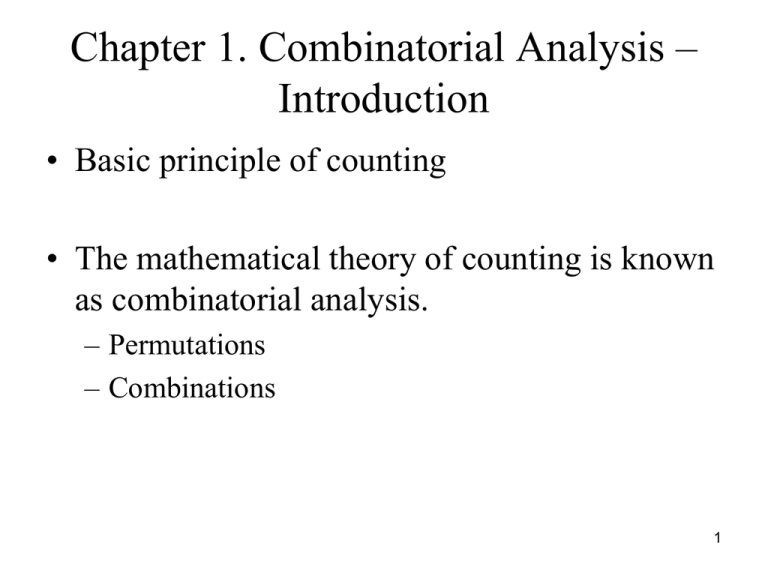
Chapter 1. Combinatorial Analysis –
Introduction
• Basic principle of counting
• The mathematical theory of counting is known
as combinatorial analysis.
– Permutations
– Combinations
1
Introductory example
• n antennas lined up in a linear order. The
system is functional as long as no two
consecutive antennas are defective. If it turns
out that exactly m of the n antennas are
defective, what is the probability that the
resulting system will be functional? For
instance n = 4 and m = 2.
2
3
The basic principle of counting
• Suppose that two experiments are to be
performed. Then if experiment 1 can result in
any one of m possible outcomes and if for each
outcome of experiment 1 there are n possible
outcomes of experiment 2, then together there
are mn possible outcomes of the two
experiments.
4
Proof by enumeration
• A student takes two courses in a semester and
each course can result in one of the five
possible grades: A, B, C, D and F.
• How many different outcomes can the student
get for the semester?
5
A different question
• A student will take one of two possible courses
in a semester and each course can result in one
of the five possible grades: A, B, C, D and F.
• How many different outcomes can the student
get for the semester?
6
• Ex 2a
A small community consists of 10 women
each with 3 children. If one woman and one of
her children are to be chosen as mother and
child of the year, how many different choices
are possible? How about if one woman and
one child of any woman are to be chosen?
How about if one woman or one children is to
be chosen as person of the year?
10 × 3 = 30
10 × 30 = 300
7
10 + 30 = 40
Generalized basic principle of counting
• If r experiments that are to be performed are such that
the first one may result in any of n1 possible
outcomes, and if for each of the n1 possible outcomes
there are n2 possible outcomes of the second
experiment and if for each of the possible outcomes
of the first two experiments there are n3 possible
outcomes of the third experiments, and if …, then
there is a total of n1n2 … nr-1nr possible outcomes
of the r experiments.
8
• Ex 2b
A college planning committee consists of 3
freshmen, 4 sophomores, 5 juniors and 2
seniors. A subcommittee of 4, consisting of 1
person from each class, is to be chosen. How
many different subcommittees are possible?
3 × 4 × 5 × 2 = 120
9
What is the number of vehicles in
US in 2009?
•
•
•
•
•
A: < 100,000,000
B: 100,000,000 – 200,000,000
C: 200,000,000 – 300,000,000
D: 300,000,000 – 400,000,000
E: > 400,000,000
254,212,610 in 2009
10
Ex 2c
• How many different 7-place license plates are
possible if the first 3 places are to be occupied
by letters and the final 4 by numbers?
26×26×26×10×10×10×10 = 175,760,000
• How about if repetition among letters and
numbers were prohibited?
26×25×24×10×9×8×7 = 78,624,000
11
Permutations
• Often we are interested in the different orders of
some objects.
– For example, people may want to rank some products, A,
B, C and their order can be ABC, ACB, BAC, BCA, CAB,
CBA, totally 6 possible ranking orders. Each arrangement
is called a permutation. There are totally 6 possible
permutations.
– Matching a set of n distinct things to another set of n
distinct things where each one in the first set need to be
matched to one and only one in the second set.
• Can we come out with a formula to compute the total
number of permutations? Suppose we have n objects.
n(n-1)(n-2)…3·2·1 = n!
12
Ex 3a
• How many different batting orders are possible
for a baseball team consisting of 9 players?
• 9*8*7*6*5*4*3*2*1 = 9!
13
Ex 3b
• A class in probability theory consists of 6 men
and 4 women. An examination is given, and the
students are ranked according to their
performance. Assume that no two students obtain
the same score.
• a) how many different rankings are possible?
10*9*8*7*6*5*4*3*2*1 = 10!
• b) If the men are ranked among themselves and
the women among themselves, how many
different rankings are possible?
Rankings for men: 6!
Rankings for women: 4!
Ranking for all: (6!)(4!) = (720)(24)
14
Ex 3c
• Ms Jones has 10 books that she is going to put
on her bookshelf. Of there, 4 are mathematics
books, 3 are chemistry books, 2 are history
books, and 1 is a language book. Jones wants
to arrange her books so that all the books
dealing with the same subject are together on
the shelf. How many different arrangement are
possible?
15
Divide and Conquer!
• 1 Divide: Divide a complex process into several
smaller, easier steps.
– This step can be crucial and you need to learn to
master it.
• 2 Conquer: Solve each step separately.
– This should be easier
– If not, maybe you want to go back to Divide step.
– put everything together
• Divide and conquer can be very useful in your
work and daily life, too!
16
Ex. 3c Divide
• Step 1: We can first arrange the four subjects:
math, chemistry, history and language.
• Step 2: We can then arrange 4 math books
among themselves
• Step 3: We can then arrange 3 chemistry books
• Step 4: Arrange 2 history books
• Step 5: Arrange 1 language book
17
Ex. 3c Conquer
• Step 1: arrange the four subjects: math, chemistry,
history and language.
– 4*3*2*1 = 4!
• Step 2: arrange 4 math books among themselves
– 4*3*2*1 = 4!
• Step 3: arrange 3 chemistry books
– 3!
• Step 4: History books
– 2!
• Step 5: Language book
– 1
18
Ex. 3C Putting things together
• The total number of ways to arrange all the
books is
– Number of arrangements in the 1st step * # of
arrangement in the 2nd step * # of arrangement in
the 3rd step * # in the 4th step * # in the 5th step.
• 4!4!3!2!1! = 6921
19
• Number of permutations of a set of n objects
when certain of them are indistinguishable
from each other.
• Ex 3d
How many different letter arrangements can be
formed using the letters P E P P E R?
20
• There are 6! permutations if the Ps and Es are
different: P1E1P2P3E2R
• Look at one particular permutation: P1P2E1P3E2R,
if we permute the P’s among themselves and E’s
among themselves, then the arrangement would
still be of the form PPEPER, and that is 3!2!
permutations are of the form PPEPER.
• If X is the number of arrangement we want to
compute then we have
X * 3!2! = 6!
X = 6! / (3!2!)
21
• In general, the same reasoning as that used in
Ex 3d shows that there are n!/(n1!n2!...nr!)
different permutations of n objects, of which n1
are alike, n2 are alike, … nr are alike.
22
Ex 3e
A chess tournament has 10 competitors of which
4 are Russian, 3 are from the United States, 2
from Great Britain, and 1 from Brazil. If the
tournament result lists just the nationalities of the
players in the order in which they places, how
many outcomes are possible?
n = 10 competitors. Among them, n1 = 4 are alike
(Russian), n2 = 3 are alike (US), n3 = 2 are alike
(GB), and n4 = 1 are alike (Brazil).
n!/(n1!n2!n3n4!) =10!/(4!3!2!1!) = 12,600
23
Combinations
• The number of different groups of r objects
that could be formed from a total of n objects.
• How many different groups of 3 could be
selected from the 5 items A, B, C, D, and E?
• 5*4*3/(3*2*1) = 10
24
• In general, the number of different groups of r
items that could be formed from a set of n
items is
n(n 1) (n r 1)
n!
r!
(n r )!r!
25
Notation and terminology
n
We define , for r n, by
r
n
n!
r (n r )!r !
n
and say that represents
r
the number of possible combinations
of n objects taken r at a time.
26
• Ex 4a
A committee of 3 is to be formed from a group
of 30 people. How many different committees
are possible?
30 30 29 28
4060
3 2 1
3
27
• Ex 4b
From a group of 5 women and 7 men, how
many different committees consisting of 2
women and 3 men can be formed?
5 7 5*4 7*6*5
350
2 3*2
2 3
What if 2 of the men are feuding and refuse to
serve on the committee together?
7 2 5 5
300
3 2 1 2
28
• Ex 4c
Consider a set of n antennas of which m are
defective and n-m are functional and assume
that all of the defectives and all of the
functional are considered indistinguishable.
How many linear orderings are there in which
no two defectives are consecutive?
n m 1
m
29
Binomial Coefficient
n
T he value of are oftenreferredto as
r
binomialcoefficients. T hisis so because of
the binomialtheoremas statedfollowing:
n k nk
( x y ) x y
k 0 k
n
n
30
Combinatorial Proof
• Consider (x1+y1)(x2+y2)…(xn+yn)
• Its expansion consists of the sum of 2n terms, each
term being the product of n factors.
• Each of the 2n terms in the sum will contain as a
factor either xi or yi for each i = 1, 2, … n.
• How many of the 2n terms in the sum will have k of xi
and (n-k) of yi?
• As each term consisting of k of xi and (n-k) of yi
corresponds to a choice of a group of k from the n
values x1, x2, …, xn, there are n choose k such terms.
• Thus, letting xi = x, yi = y, i = 1,…, n, we see that
n k nk
( x y) x y
k 0 k
n
n
31
• Ex 4d
Expand (x+y)3
n k nk
( x y) x y
k 0 k
n
n
32
• Ex 4e
How many subsets are there of a set consisting
of n elements?
n
n
n
k (1 1) 2
k 0
n
33
Multinomial coefficients
• A set of n distinct items is to be divided into r
distinct groups of respective sizes n1, n2, …, nr,
where summation of them equals to n. How
many divisions are possible?
34
35
Notation
n
by
If n1 n2 nr n, define
n1 , n2 , nr
n
n!
n1 , n2 , nr n1!n2 ! nr !
n
represent st henumber of
T hus
n1 , n2 , nr
possible divisionsof n dist inct object sint o r dist inct
groups of respect ivesizes n1 , n2 , nr .
36
• Ex 5a
A police department in a small city consists of
10 officers. If the department policy is to have
5 of the officers patrolling the streets, 2 of the
officers working full time at the station, and 3
of the officers on reserve at the station, how
many different divisions of the 10 officers into
the 3 groups are possible?
10!
2520
5! 2! 3!
37
• Ex 5c
In order to play a game of basketball, 10
children at a playground divide themselves
into two teams of 5 each. How many different
divisions are possible?
10! /(5! 5!)
126
2!
38
• Ex. 5d
• In the first round of a knockout tournament
involving n=2m players, the n players are divided
into n/2 pairs, with each of these pairs then
playing a game. The losers of the games are
eliminated while the winners go on to the next
round, where the process is repeated until only a
single player remains. Suppose we have a
knockout tournament of 8 players.
• (a) How many possible outcomes are there for the
initial round?
• (b) How many outcomes of the tournament are
possible, where an outcome gives complete
information for all rounds?
39
40
41
My journey to become a great chef
20 20!
1140
3 3!17!
1140 / 50 22.8
42
Summary of Chapter 1
• Basic principle of counting
• Permutation n!
– Possible linear ordering of n items.
• Combination
– Number of different subgroups of size r that can be
chosen from a set of size n.
– n!/((n-r)!r!)
43
• Prob. 1.2 How many outcome sequences are
possible when a die is rolled four times?
– Four experiments each with 6 outcomes
– 6 outcome for the first rolling
– For each outcome of the first rolling, there are 6
outcome for the second rolling
• 6*6 for the first two
– For each outcome of the first two rolling, there are
6 outcome for the third rolling
• 6*6*6 for the first three rolling
– Total is 6*6*6*6 = 64
44
• Prob. 1.4 John, Jim, Jay, and Jack have formed
a band consisting of 4 instruments. If each of
the boys can play all 4 instruments, how many
different arrangements are possible? What if
John and Jim can play all 4 instruments, but
Jay and Jack can each play only piano and
drums?
• 4*3*2*1 = 4! = 24
• 2!*2! = 4
45
• Prob. 1.5. For years, telephone area codes in
the US and Canada consisted of a sequence of
three digits. The first digit was an integer
between 2 and 9; the second digit was either 0
or 1; the third digit was any integer between 1
and 9. How many area codes were possible?
How many area codes starting with a 4 were
possible?
• 8*2*9 = 144
• 1*2*9 = 18
46
Prob. 1.7.
(a) In how many ways can 3 boys and 3 girls sit in a row?
6!
(b) In how many ways can 3 boys and 3 girls sit in a row
if the boys and the girls are each to sit together?
2!3!3!
(c) In how many ways if only the boys must sit together?
4!3!
or 4*3!*3!
(d) In how many ways if no two people of the same sex
are allowed to sit together?
2*3!3!
47
• Prob. 1.8. How many different letter
arrangements can be made from the letters
• (a) fluke;
– 5!
• (b) propose;
– 7!/(2!2!)
• (c) mississippi;
– 11!/(4!4!2!)
• (d) arrange?
– 7!/(2!2!)
48
• Prob. 1.10. In how many ways can 8 people be seated
in a row if
• (a) there are no restrictions on the seating arrangement;
– 8!
• (b) person A and B must sit next to each other;
– 7!2! Or 2!*7*6!
• (c) there are 4 men and 4 women and no 2 men and 2
women can sit next to each other;
– 2*4!4!
• (d) there are 5 men and they must sit next to each other;
– 4!5!
• (e) there are 4 married couples and each couple must sit
together?
– 4!2!2!2!2!
49
• Prob. 1.13. Consider a group of 20 people. If
everyone shakes hands with everyone else,
how many handshakes take place?
20
20!/(2!18!) 20*19 / 2 190
2
50
• Prob. 1.15. A dance class consists of 22
students, 10 women and 12 men. If 5 men and
5 women are to be chosen and then paired off,
how many results are possible?
12 10
5!
5 5
51
• Prob. 1.17. A total of 7 different gifts are to be
distributed among 10 children. How many
distinct results are possible if no child is to
receive more than one gift?
10
7! 10!/(10 7)! 10!/ 3!
7
52
• Prob. 1.21. Consider the grid of 4*5 points
shown below. Suppose that starting at point
labeled A you can go one step up or one step
to the right at each move. This is continued
until the point labeled B is reached. How many
different paths from A to B are possible?
B
A
7!/(3!4!)
53





